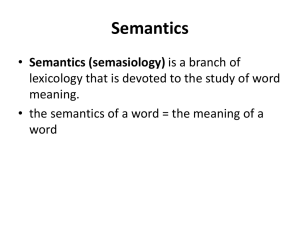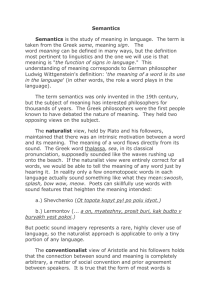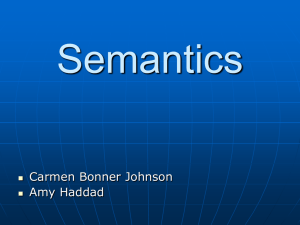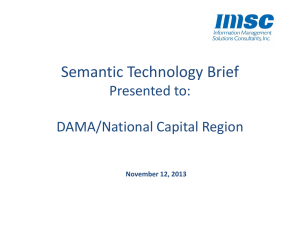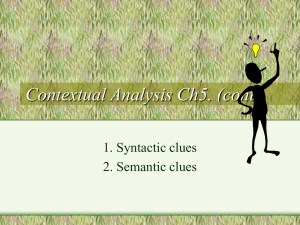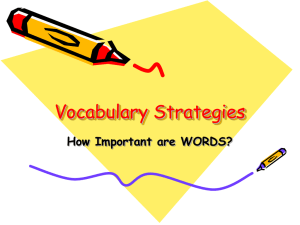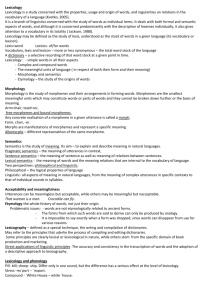Semasiology 1. The Definition of Meaning 2. Types of Meaning 3
advertisement
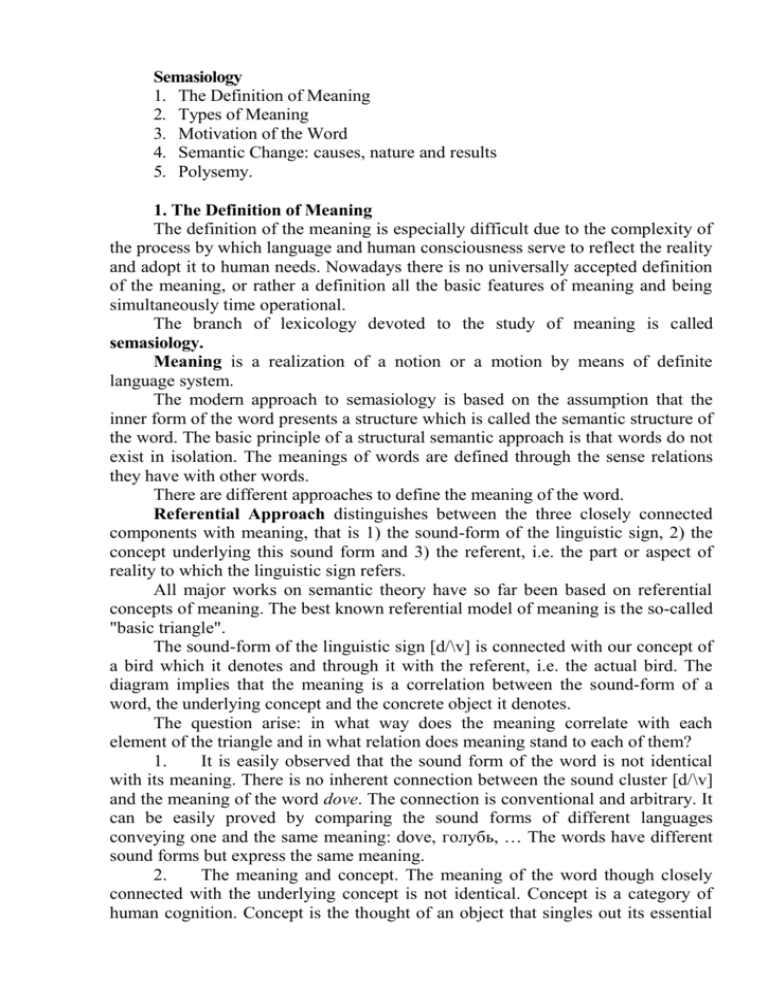
Semasiology 1. The Definition of Meaning 2. Types of Meaning 3. Motivation of the Word 4. Semantic Change: causes, nature and results 5. Polysemy. 1. The Definition of Meaning The definition of the meaning is especially difficult due to the complexity of the process by which language and human consciousness serve to reflect the reality and adopt it to human needs. Nowadays there is no universally accepted definition of the meaning, or rather a definition all the basic features of meaning and being simultaneously time operational. The branch of lexicology devoted to the study of meaning is called semasiology. Meaning is a realization of a notion or a motion by means of definite language system. The modern approach to semasiology is based on the assumption that the inner form of the word presents a structure which is called the semantic structure of the word. The basic principle of a structural semantic approach is that words do not exist in isolation. The meanings of words are defined through the sense relations they have with other words. There are different approaches to define the meaning of the word. Referential Approach distinguishes between the three closely connected components with meaning, that is 1) the sound-form of the linguistic sign, 2) the concept underlying this sound form and 3) the referent, i.e. the part or aspect of reality to which the linguistic sign refers. All major works on semantic theory have so far been based on referential concepts of meaning. The best known referential model of meaning is the so-called "basic triangle". The sound-form of the linguistic sign [d/\v] is connected with our concept of a bird which it denotes and through it with the referent, i.e. the actual bird. The diagram implies that the meaning is a correlation between the sound-form of a word, the underlying concept and the concrete object it denotes. The question arise: in what way does the meaning correlate with each element of the triangle and in what relation does meaning stand to each of them? 1. It is easily observed that the sound form of the word is not identical with its meaning. There is no inherent connection between the sound cluster [d/\v] and the meaning of the word dove. The connection is conventional and arbitrary. It can be easily proved by comparing the sound forms of different languages conveying one and the same meaning: dove, голубь, … The words have different sound forms but express the same meaning. 2. The meaning and concept. The meaning of the word though closely connected with the underlying concept is not identical. Concept is a category of human cognition. Concept is the thought of an object that singles out its essential features. Concepts are the result of abstraction and generalization. Thus they are almost the same for the whole of humanity in one and the same period of its historical development. The meanings of words, however, are different in different languages. Compare: “a building for human habituation” – HOUSE, ДОМ; “fixed residence of family or household” – HOME, ДОМ. These examples show that the concepts expressed by one and the same word in one language can be expressed by two different words in the other language. 3. Distinguishing meaning from the referent is of the utmost importance. Firstly, meaning is linguistic, whereas the referent is beyond the scope of language. One and the same object can be denoted by more than one word of a different meaning, e.g., the referent “CAT” be denoted by the words “cat”, “animal”, “Tom”, “this”, “pet”, etc. All these words have the same referent but different meanings. Besides, there are words that have distinct meaning but do not refer to any existing thing, e.g., mermaid – an imagery sea creature that has the upper body of a woman and a fish tail. The conclusion is obvious – meaning is not to be identical with any of the three points of the triangle, but closely connected with them. Functional approach. In recent years a new and entirely different approach to meaning, known as the functional approach, has begun to take shape in linguistics and especially in structural linguistics. The functional approach maintains that the meaning of a linguistic unit can be studied only through its relation to other linguistic units. In a very simplified form this view may be illustrated by the following: we know, for instance, that the meaning of the two words move and movement is different because they function in speech differently. Comparing the contexts in which we find these words we cannot fail to observe that they occupy different positions in relation to other words. (To) move, e.g., can be followed by a noun (move the chair), preceded by a pronoun (we move), etc. The position occupied by the word movement is different: it may be followed by a preposition (movement of smth), preceded by an adjective (slow movement), and so on. As the distribution of the two words is different, we are entitled to the conclusion that not only they do belong to different classes of words, but that their meanings are different, too. The same is true of different meanings of one and the same word. Analyzing the function of a word in linguistic contexts and comparing these contexts, we conclude that meanings are different (or the same) and this fact can be proved by an objective investigation of linguistic data. For example, we can observe the difference of the meanings of the word take if we examine its functions in different linguistic contexts, take the tram (the taxi, the cab, etc.) as opposed to to take to somebody. The functional approach is sometimes described as contextual as it is based on the analysis of various contexts. That is the context that determines which of the possible meanings of a polysemantic word is used. 2. Types of meaning Word-meaning is not homogeneous. It is made up of various components. These components are described as types of meaning. The two main types of meaning are the grammatical (categorical) meaning and the lexical (material) meaning. The grammatical meaning is defined as an expression in speech of relationship between words. GM is the component of meaning recurrent in identical sets of individual forms of different words: the tense meaning (asked, thought, walked); the case meaning (girl's, boy's, night's); the meaning of plurality (joys, tables, places). Grammatical meaning is generalized in the most abstract part of the meaning of the word; it is common to all the words belonging to this part of speech. It is that part of meaning which recurs in the identical forms of different words of the same class, e.g., big, bigger, the biggest. The lexical meaning is the meaning proper to the given linguistic unit in all its forms and distributions. The word-forms go, goes, went, going, gone possess different grammatical meanings of tense, person, number, but in each form they have one and the same semantic component denoting 'the process of movement'. Lexical meaning is not indivisible, it may be analyzed in three components: denotational, connotational, and pragmatic. One part of meaning expressing a notion is called denotation. Denotational meaning establishes correlation between the name and the object, process or characteristic feature of concrete reality (or thought) which is denoted by the given word. Denotation expresses a notion. Denotation is objective, it reflects objective reality through notions. The other part of meaning may express a personal attitude of the speaker to the object of speech, or it may characterize the role of the speaker in the process of communication. The subjective part of meaning is the connotation of the word. Connotations are subjective, they characterize the speaker, his attitude, his social role. There are four types of connotation: 1. Emotional connotation shows the emotional attitude of the speaker to the object of speech, e.g., daddy - father 2. Evaluative connotation characterizes the object positively or negatively, e.g., clique - group 3. Expressive connotation characterizes an object as having a great degree of some quality. It is subdivided into: a) Quantitative (in which meaning is the component of the words very or much), e.g., calamity, disaster, b) Imaginative type to which words in figurative meaning belong, e.g., a monkey. 4. Stylistic connotation characterizes the social role of the speaker. All the words which are used in limited spheres of communication are marked by stylistic connotation, e.g., to do in, to kick the bucket. The pragmatic aspect conveys information on the situation of communication. It includes: Information on the “time and space” relationship of the participants, e.g., come – go, behold – beholder, Information on the participants and the given language community, e.g., compare: they chucked a stone at the cops and after casting a stone at the police… . The language used may be indicative of the social status of a person, his profession, education and so on. Information on the tenor of discourse that is usually based on social or family roles of the participants: a stranger talking to a stranger; two friends discussing matters of the interest, a teacher talking to a student and a student interviewed by the dean, etc. Information on the register of communication (formal, informal, neutral). 3. Motivation of the Word Motivation denotes the relationship between the phonemic or morphemic composition and structural pattern of the word on the one hand, and its meaning on the other. Motivation can be of three types: morphological, phonetical and sematic. Morphological motivation implies a direct connection between the morphological structure of the word and its lexical meaning. One-morpheme words, e.g., sing, tell are non-motivated. The meaning of words composed of more than one morpheme is the combined meaning of the morphemes and the meaning of the structural pattern of the word itself, e.g., finger-ring (кольцо, которое носят на пальце руки) and ring-finger (палец, на котором носят обручальное кольцо) the morphemes are phonetically identical with identical lexical meaning. The difference in the meaning can be accounted for by the difference in the arrangement of the component morphemes. Morphological motivation is relative. The degree of motivation varies from complete motivation to lack of motivation with various grades of partial motivation, e.g., endless ~ completely motivated (lexically and structurally); cranberry partially (there is no lexical meaning of the morpheme cran-). Phonetical motivation is a direct connection between the phonetical structure of the word and its meaning, e.g., swish, sizzle, boom, splash mean a direct imitation of the sounds these words denote. Semantic motivation is based on co-existence of direct and figurative meanings of the same word. Mouth - a part of the human face, but at the same time it can be applied to any opening or outlet: the mouth of a river, of cave. Jacket is a short coat and also a protective cover for a book. As to compounds, their motivation is morphological if the meaning of the whole is based on the direct meaning of the components, and semantic if the combination is used figuratively: watchdog - a dog kept for watching property (morphologically motivated); a watchful human guardian (semantically motivated). 4. Causes, nature and results of semantic change Word meaning is liable to change in the course of the historical development of the language. The factors accounting for semantic changes may be roughly subdivided into two groups: extra-linguistic; linguistic. Causes of semantic change By extra-linguistic causes various changes in the life of the speech community are meant, i.e. changes in economic and social structure, changes in scientific concepts. hlaford - original meaning - 'bread-keeper' («хранитель хлеба»), and later on 'master, ruler' («повелитель, лорд). Linguistic causes: 1. Discrimination/differentiation of synonyms. In OE the word land meant both 'solid part of earth's surface' and 'the territory of a nation'. In the Middle English period the word country was borrowed as its synonym. The meaning of the word land was somewhat altered and 'the territory of a nation' came to be denoted by the borrowed word country. 2. Ellipsis. In a phrase made up of two words one of these is omitted and its meaning is transferred to a partner, e.g., to starve in Old English (OE) meant 'to die' and was habitually used in collocation with the word hunger. In the 16th century the verb to starve itself acquired the meaning 'to die of hunger'. 3. Fixed context may be regarded as another linguistic factor in semantic change. For example, the word token, when brought into competition with the loan word sign, became restricted in use to a number of set expressions, such as love token, token of respect and also became specialized in meaning. Nature of Semantic Change A necessary condition of any semantic change is some connection, some association between the old meaning and the new one. There are two kinds of association involved in various semantic changes: similarity of meanings; contiguity of meanings. Similarity of meanings or metaphor may be described as the semantic process of associating two referents, one of which in some way resembles the other. The word hand acquired the meaning ‘a pointer of a clock or a watch’ because of a similarity of one of the functions performed by the hand: ‘to point to smth’. Contiguity of meanings or metonymy may be described as the semantic process of associating two referents one of which makes part of the other or is closely connected with it. This can be illustrated by the use of the word tongue — ‘the organ of speech’ in the meaning of ‘language’ (as in mother tongue). The word bench acquired the meaning 'judges' because it was on the bench that judges used to sit in law courts. Similarly the House acquired the meaning of 'members of the House' (Parliament) Results of Semantic Change Results of semantic change can be generally observed in the changes of the denotational meaning of the word: restriction of meaning and extension of meaning. Restriction of meaning can be illustrated by the semantic development of the word hound which used to denote 'dog of any breed' but now denotes only 'a dog used in the chase'. If the word with a new restricted meaning comes to be used in the specialized vocabulary of some limited group within the speech community it is usual to speak of the specialization of meaning. Extension of meaning may be illustrated by the word target which originally meant 'a small round shield' but now means 'anything that is fired at'. If the word with the extended meaning passes from the specialized vocabulary into common use, the result of the semantic change is described as the generalization of meaning. Results of semantic change can be also observed in the alteration of the connotational aspect of meaning: amelioration of meaning and deterioration of meaning. Deterioration (or the pejorative development) of meaning implies the acquisition by the word of some derogatory emotive charge. For example, the word boor was originally used to denote 'a peasant' and then acquired a derogatory connotational meaning and came to denote ‘a clumsy or ill-bred fellow’. Amelioration of meaning implies the improvement of the connotational component of meaning. For instance, the word minister originally denoted ‘a servant’ but now — 'a civil servant of higher rank, a person administering a department of state'. 5. Polysemy Polysemy has an exceptional importance for the description of a language system and for the solutions of practical tasks connected with an adequate understanding of the meaning of a word and its use. A word may have several meanings. Then it is called a polysemantic word. Words having only one meaning are called monosemantic. Monosemantic words are few in number. These are mainly scientific terms. The bulk of English words are polysemantic. V.V.Vinogradov, the Russian linguists, admitted the importance of differentiating the meaning from the usage (a contexual variant). Meanings are fixed and common to all people, who know the language system. The usage is only a possible application of one of the meanings of a polysemantic word, sometimes very individual, sometimes more or less familiar. Meaning is not identical with usage. Thus, it may be confirmed that polysemy exists only in the language, not in speech. A.I.Smirnitsky developed Vingradov’s theory further and introduced the term 'a lexico-semantic variant' (LSV). A lexico-semantic variant is a two-facet unit (двусторонняя единица), the formal facet of which is the sound-form of a word, while the content facet is one of the meanings of the given word, i. e. the designation (обозначение) of a certain class of objects. Words with one meaning are represented in the language system by one LSV, polysemantic words — by a number of LSVs. All lexico-semantic variants of a word form a homogenous semantic structure ensuring the semantic unity of the given word. All LSVs are linked together by a certain meaning — the semantic pivot of the word called the semantic center of the word. Thus, the semantic center of the word is the part of meaning which remains constant in all the lexico-semantic variants of the word. The word in one of its meanings is termed a lexico-semantic variant of this word, e.g., the word table has at least 9 lexico-semantic variants: • a piece of furniture; • the persons seated at table; • the food put on a table; • a thin flat piece of stone, metal, wood; • a slab of stone; • plateau, extensive area of high land; • an orderly arrangement of facts, etc. There can be distinguished two approaches: diachronic and synchronic. Within the diachronic approach polysemy implies that a word may retain its previous meaning or meanings and at the same time acquire one or several new ones. Thus, according to this approach in the semantic structure of a word two types of meaning can be singled out: the primary meaning and the secondary meaning. Within the synchronic approach it is the coexistence of various meanings of the same word at a certain historical period of the development of the English language. The meaning that first occurs to us whenever we hear or see the word table is 'an article of furniture'. This emerges as the central (or basic) meaning of the word, and all other meanings are marginal (or minor) meanings. Synchronically analyzing the word table the following question arises: Do all the nine meanings of the word table equally represent the occur only in certain contexts. Questions: 1. What is the meaning of a word? 2. Characterize the referential approach. 3. Characterize the functional approach. 4. What is the grammatical meaning of a word? 5. What is the lexical meaning of a word? 6. What is the denotational aspect of the lexical meaning? 7. What is the connotational aspect of the lexical meaning? 8. What is the pragmatic aspect of the lexical meaning? 9. What types of motivation are known to you? Characterize each. 10.What linguistic causes of semantic change can be singled out? 11.What are the results of the change from the denotational aspect of the lexical meaning? 12.What are the results of the change from the connotational aspect of the lexical meaning? 13.What two kinds of the nature of semantic change can be distinguished? 14.What is polysemy? 15.Is it important to differentiate between “meaning” and “usage”? 16.What is a lexico-semantic variant of the word? Give examples. 17.What does the term “semantic centre of the word” denote? 18.What types of meaning can be singled out within the diachronic approach to polysemy? 19.What types of meaning can be singled out within the synchronic approach to polysemy?




